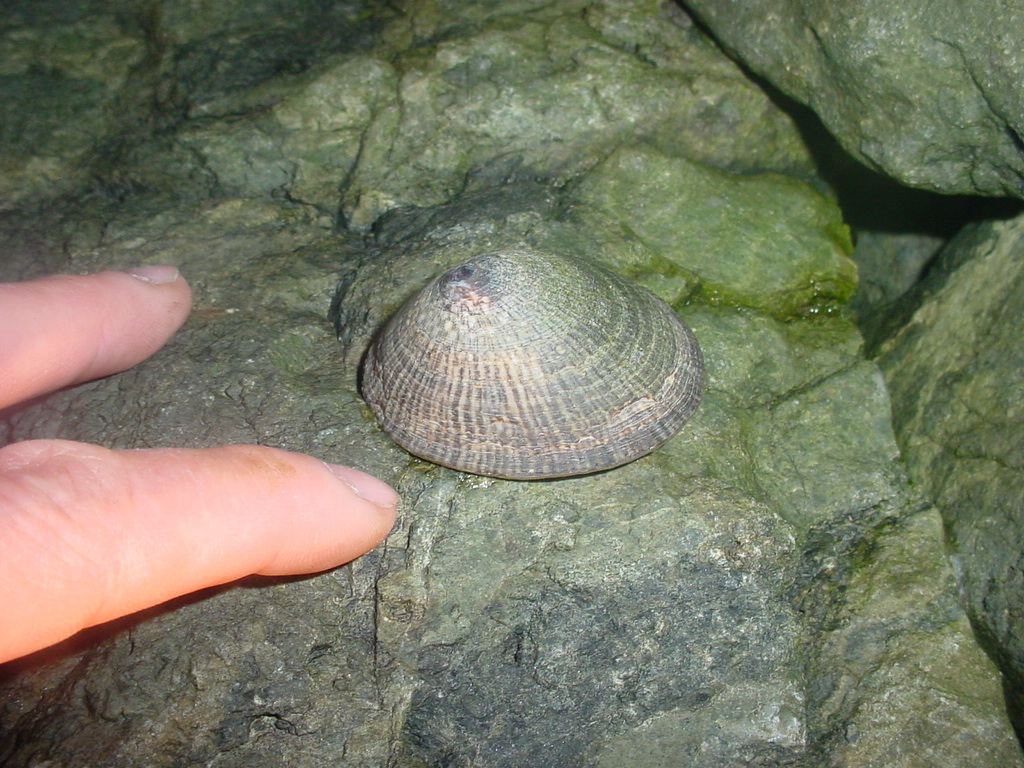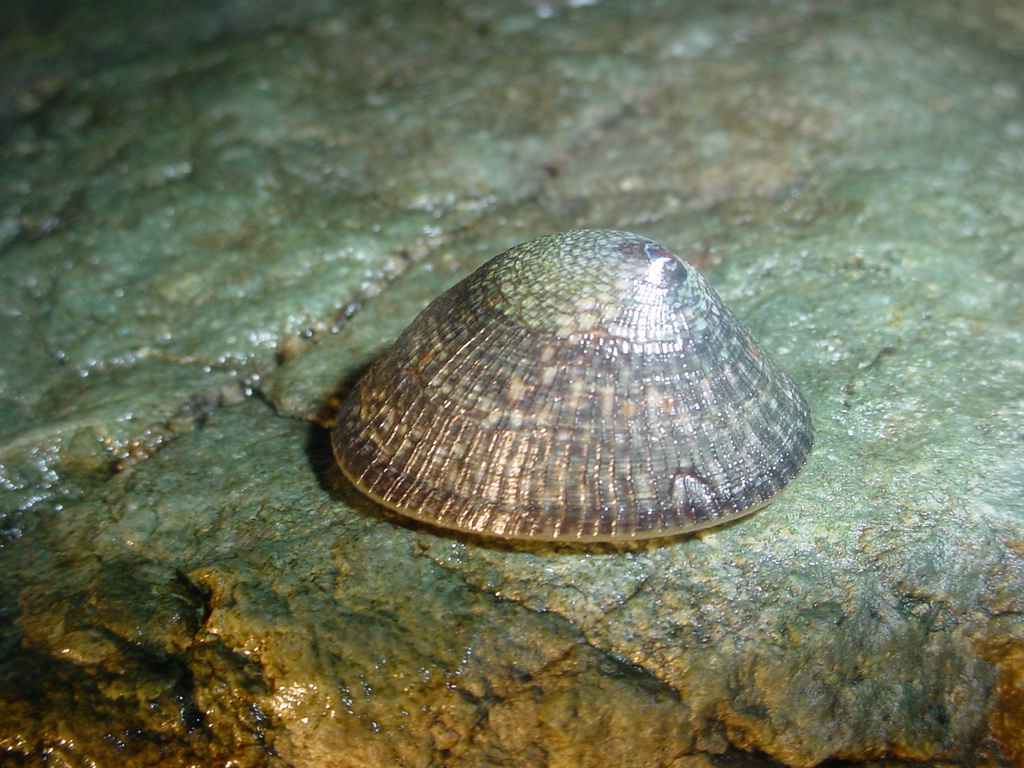Tectura persona (Rathke, 1833)Common name(s): Mask Limpet, Masked limpet, Speckled limpet, Large variegated limpet, Inflated limpet |
|
| Synonyms: Notoacmea persona, Acmaea persona |  |
| Phylum Mollusca
Class Gastropoda Subclass Prosobranchia Order Patellogastropoda Suborder Nacellina Family Lottiidae |
|
| Tectura persona crawling along a rock in the upper midlittoral at night on Sares Head | |
| (Photo by: Dave Cowles, Sept 2005) | |
How to Distinguish from Similar Species: This is the only large, inflated limpet found in the upper midlittoral zone. Tectura scutum looks very similar but it is much flatter, with a height not more than 1/3 the width.
Geographical Range: Aleutian Islands to Isla Socorro, Mexico; less common south of Monterey Bay, CA
Depth Range: Upper midlittoral
Habitat: Underside of rocks and ledges during the day, more wide-ranging at night
Biology/Natural History: This large, common intertidal species is negatively phototactic, so they are usually in crevices or on the underside of boulders during the day. It is commonly found on the roofs of sea caves. They come out to feed at night. It is one of the largest limpets that can be found in the intertidal here in the Pacific Northwest (though it does not get as large as the owl limpet, Lottia gigantea, which is found further south). The white spots on the shell are translucent, and may be used to help the animal avoid bright light. The gut of this species often has a large parasitic protozoan, Eupoterian pernix. This species can be found in brackish water. Predators include black oystercatchers, which capture many of them in the Rosario area, and crows, which may explain why they usually retreat to high up on vertical surfaces or under overhangs, in shaded places during the day. They are most common in the upper midlittoral so seastars and oyster drill snails are less likely to be a problem for them. They do not show an escape response to sea stars, as do some lower-living limpets such as the keyhole limpet Diodora aspera. In California, spawning is in March and April.
The "persona" in the name refers to the dark stain on the interior of the apex, which sometimes looks like a mask or a person's face.
| Return to: | |||
| Main Page | Alphabetic Index | Systematic Index | Glossary |
References:
Dichotomous Keys:Flora and Fairbanks, 1966 (as Acmaea persona)
Kozloff 1987, 1996
Smith and Carlton, 1975 (as Notoacmea persona)
General References:
Brusca
and Brusca, 1978 (as Notoacmea persona)
Carefoot,
1977 (As Notoacmea persona)
Harbo,
1997
Harbo,
1999
Johnson
and Snook, 1955 (as Acmaea persona)
Kozloff,
1993
McConnaughey
and McConnaughey, 1985 (as Notoacmea persona)
Morris,
1966 (as Acmaea persona)
Niesen,
1997
O'Clair
and O'Clair, 1998
Ricketts
et al., 1985 (as Notoacmea persona)
Sept,
1999
Scientific Articles:
Bullock, T.H., 1953. Predator recognition and escape
responses
of some intertidal gastropods in the presence of starfish.
Behavior
5: 130-140
Web sites:
General Notes and Observations: Locations, abundances, unusual behaviors:
A student study at Rosario by Pick and Reiswig (2007) found
that the
black oystercatchers Haematopus bachmani nesting on
Northwest Island
are being selective in the limpets they capture. Although Lottia
digitalis was the most common limpet found in intertidal
transects
on Northwest Island and were the species found at the highest tide
levels
so they should have been more available than any other species, they
were
not the most abundant in shell middens found near the oystercatcher
nesting
and feeding site. The oystercatchers selected Lottia
digitalis
less often than expected, and those they did select were near the
maximum
size range found in the intertidal. The oystercatchers seemed
to
prefer other, larger limpet species such as Tectura persona,
Tectura
scutum, and Lottia pelta, all of which
were found by chi-squared
analysis to be in significantly higher numbers in the midden than
expected
from the intertidal abundance. Whether this selection by the
oystercatchers
is due to a specific selection of species or simply a selection of the
largest individuals present in the intertidal is not known.

In this view one can see the apex which inclines forward; the inflated
nature of the posterior slope of the shell, and the fact that this
limpet
is much taller than is Tectura
scutum.
Night photo by Dave Cowles, Sept 2005.

This individual was at Swirl Rocks. Total length about 3-4
cm.
Photo by Dave Cowles, July 2007

The degree of development of the apical blotch and the dark marginal
line can vary considerably, as seen in this assemblage of Tectura
persona
shells collected near a black oystercatcher nesting and feeding area.
Photo by Dave Cowles, July 2007
Authors and Editors of Page:
Dave Cowles (2005): Created original page